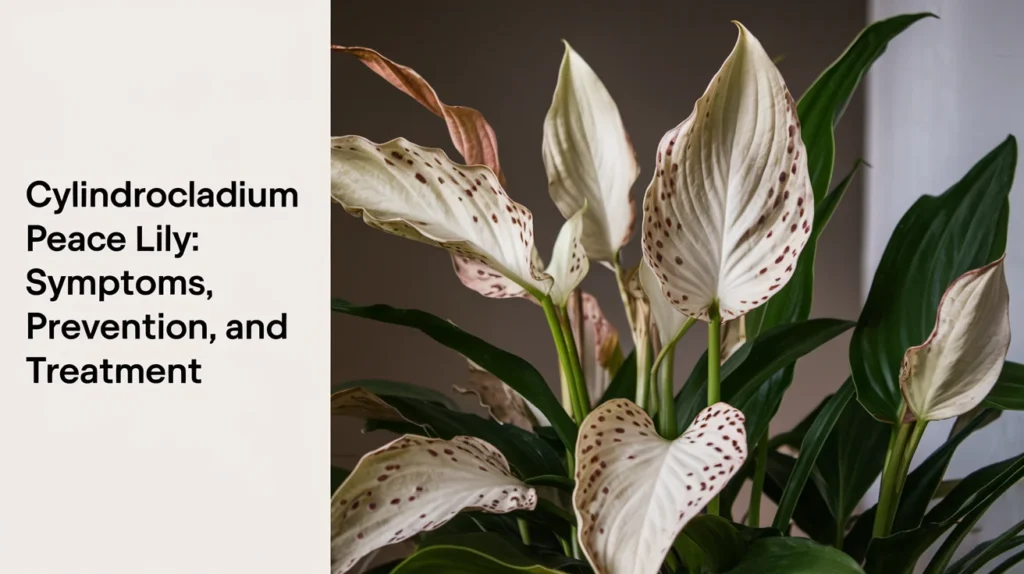The peace lily is a popular houseplant. It has white flowers and dark green leaves. However, like any other plant, it can be challenged. One worrying threat is a fungal infection caused by Cylindrocladium peace lily. The disease, more tolerant of fungus than local ones, is called ‘Cylindrocladium peace lily infection.’ There are ways to protect our precious plant. This article aims to provide support for that. This article will cover the symptoms, prevention, and treatment of this fungal problem. It will give you all the details you need.
What is Cylindrocladium peace lily infection? 🤔
Cylindrocladium is a general term for various fungi. They affect several plants, including the peace lily (Spathiphyllum). A peace lily’s health rapidly declines when infected by Cylindrocladium spathiphylli. This infection mainly attacks the roots and soil. It quickly spreads to the stems and leaves. This makes treatment hard if curative measures have not begun.
This fungal disease thrives in warm, moist environments. So, it often occurs in indoor plants that are overwatered and kept in high humidity. If your peace lily is unhealthy after having it for a while, you must know if Cylindrocladium is the cause. You need to take the right steps if it is.
Symptoms of Cylindrocladium infection in peace lilies. 😨
Early detection of symptoms of Cylindrocladium infection helps the plant heal. Here are the most common signs:
Wilting and Drooping 🌱💔
The first symptom that you will observe is wilting of the plant. Although the plant may be watered, wilting will still occur due to the fact that the fungus has infected the roots, and the plant thus cannot access water as it should.
Yellowing Leaves 🍂
In time, as the disease develops, yellowing of leaves occurs mostly toward the bottom or base of the plant. In some instances, the drooping of the leaves may occur without the yellowing. Neglecting the fungus will cause degeneration despite its pleasing effects.
Stem Rot 🌾
A constant symptom that the fungus tends to cause is rot at the base of the stem, which is usually termed soft rot. This is an important observation to watch for. It indicates that the peace lily has a Cylindrocladium disease.
Black or brown lesions. ⚫
In some worse scenarios, one can see black or brown spots on the leaves and stems. These lesions show that the fungus has developed further. They may mean that the infection is in the whole plant.
Root Decay 🪱
However, when you pull the plant from the pot, you’ll find the roots are black or dark brown and rotten. These roots are healthy and should be white or light brown in color.

How to Prevent Cylindrocladium Infection in Peace Lilies 🛡️
As prevention is better than touchscreen therapy, avoid the fungus, Cylindrocladium. It’s a disease you don’t want to encounter. Here are some steps to help you avoid it:
Avoid Overwatering 💧🚫
Peace lilies prefer moist soil. But too much water can let beetles thrive. They can cause a disease in the peace lily’s parent. Keep the right moisture levels. Reduce flooding to avoid saturating the top inch of the soil.
Ensure Proper Ventilation 🌬️
Fungi thrive in humid, stuffy places. So, ventilate your peace lily to prevent fungal growth. Keeping the plant outdoors in a well-ventilated area or near a fan will help reduce humidity.
Unearth Use Sterilized Soil 🔄 🌾
If you’re planning on repotting your peace lily, do not forget to take fresh, sterilized soil. Spores and other such structures that could be harbored in the soil can infect your plant.
Maintain Cleanliness of Plants 🪴 🧼
Every now and then, dust your peace lily leaves with a damp cloth. This will prevent dust and fungal spores from building up. Healthy and clean leaves are less likely to get infected.
Group Isolation from Other Plants 👩🌾🚪
If you find a peace lily with a fungal infection, like T. pygmaea, remove it immediately. That will help stop the infection from moving toward the healthy plants.
How to Treat Cylindrocladium Peace Lily Infection 🩹
In case your peace lily is already infected by a ‘Cylindrocladium spathiphylli,’ there is no time to waste. The following are the steps you can take to correct the situation:
Reaction: Pressing the Affected Areas ✂️🌿
The first step is to prune leaves, stems, and roots affected by the disease. Get hold of disinfectant wipes to wipe out the infected areas, such as stems. Be sure to throw the stem-cut portions into the rubbish bin, not the compost bin. This will prevent fungal diseases from creeping in.
Replace the plant’s pot. 🪴🔄
Once you cut out the diseased portions, replant your peace lily in new, healthy, and sterile soil. If using the same pot, wash it to remove all soap. Better yet, buy a new pot, free of any fungal spores.
Put a fungicide into action. 🧪🌿
If applied early enough, fungicides might help with Cylindrocladium infection. Purchase a fungicide that is made for indoor plants and mix and use it as directed. Drench the soil and the rest of the plant in the treatment to exterminate the remaining spores.
Modify the Caring Regimen for the Infection. 🌞💧
When your peace lily has been brought under control, change how you provide care for your plant. Avoid too-frequent irrigation. There should be good airflow, and the plant should get bright, indirect light.
The bright side is that your knife will kill the Cylindrocladium infection if you act quickly. However, the plant’s recovery depends on the infection’s stage when treatment started. Since you all must have done the right thing, there is a possibility of the plant bouncing back and doing well. However, if the infection was high, your peace lily may take longer than expected to heal.
Conclusion:
It’s a wretched but understandable mistake to blame the fungus for the Cylindrocladium disease on peace lilies. Wilting, yellow leaves, stem rot, and any other signs should alert you to the possibility of the disease, and you may take action before it spreads. To prevent fungal infections in your peace lily, manage watering, airflow, and soil sterilization.
In case any of the plants suffer from Cylindrocladium, there is no cause for alarm. After a period of proper care and treatment of the plant, your peace lily will regain its vibrant health. Moreover, maintain your peace lily plant care schedule and sit down to look at its beautiful foliage for many years.


















